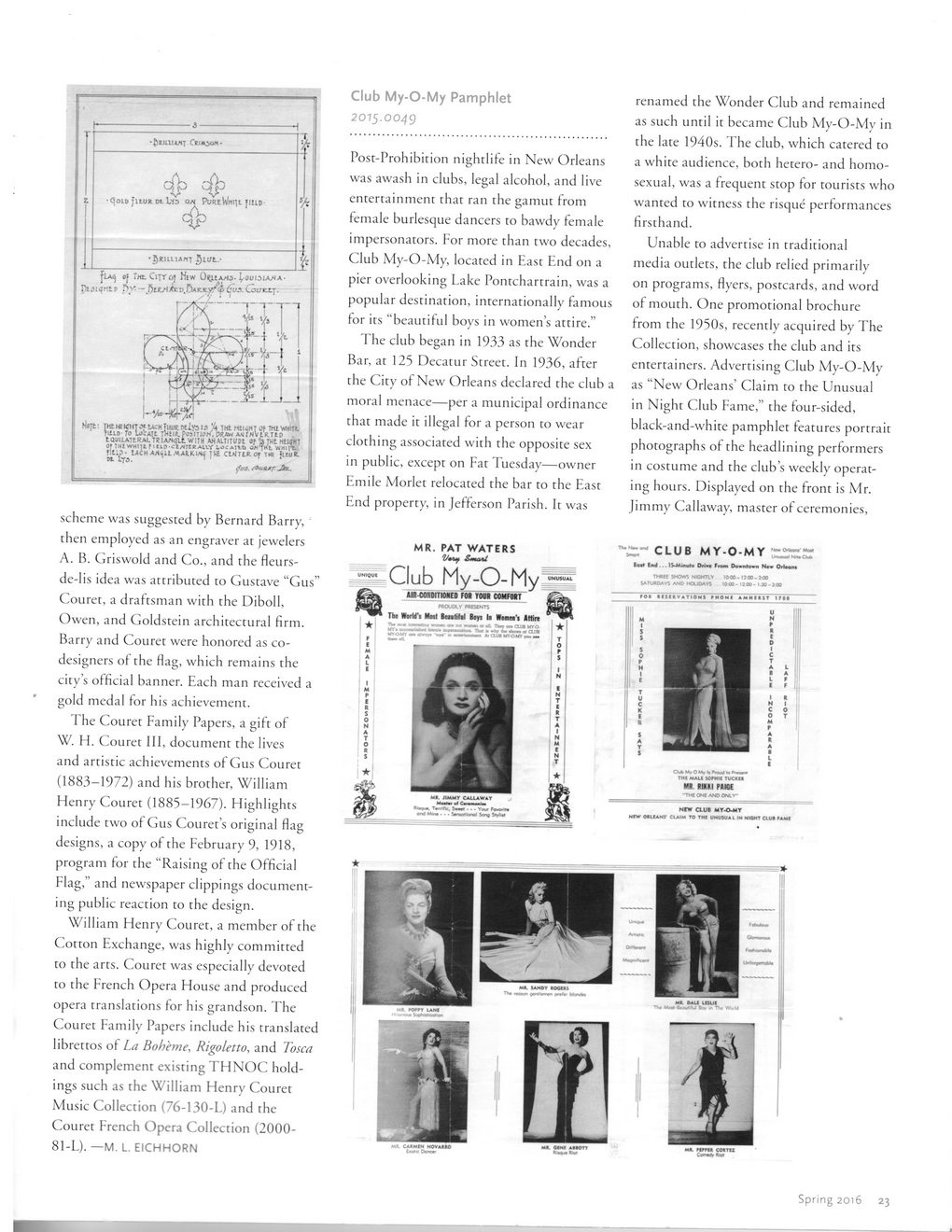This text was obtained via automated optical character recognition.
It has not been edited and may therefore contain several errors.
•qoi© juu*Dt.Vfd ox PyRtWw^t yitiD •I>RUUArtT Of TrttClTrOJ HlW Oy.tA/13- ^OUIOJA/JA-ptdiqhtP r>v: — 6ufi. Coir try. 5/* H«t: THtHtMfHTOf tACHTlfUK1 ® 'k TMt H6I<5HT Of TMi'WHITt TltlO To UcATt T"H*.P05»T10H,PRJiWA>jfwVtR.TtD LQUlLATtRALTRIA/tflE. WITH AHALTlTUDt Of ij TH£ HUtfHT Of THZWHIU fieip-tfl^reBAlVY I.OCA11* ofllHL WHii't fit:?- LKHA^ltMAHKt/^ jtf CUJUROf THE jituR. Club My-O-My Pamphlet 201$.OO49 scheme was suggested by Bernard Barry, then employed as an engraver at jewelers A, B. Griswold and Co., and the fleurs-de-lis idea was attributed to Gustave “Gus” Couret, a draftsman with the Diboll, Owen, and Goldstein architectural firm. Barry and Couret were honored as codesigners of the flag, which remains the city’s official banner. Each man received a gold medal for his achievement. The Couret Family Papers, a gift of W. H. Couret III, document the lives and artistic achievements of Gus Couret (1883—1972) and his brother, William Henry Couret (1885—1967). Highlights include two of Gus Couret’s original flag designs, a copy of the February 9, 1918, program for the “Raising of the Official Flag,” and newspaper clippings documenting public reaction to the design. William Henry Couret, a member of the Cotton Exchange, was highly committed to the arts. Couret was especially devoted to the French Opera House and produced opera translations for his grandson. The Couret Family Papers include his translated librettos of La Boheme, Rigoletto, and Tosca and complement existing THNOC] holdings such as the William Henry Couret Music Collection (76-130-L) and the Couret French Opera Collection (2000-81-L). —M. L. EICHHORN Post-Prohibition nightlife in New Orleans was awash in clubs, legal alcohol, and live entertainment that ran the gamut from female burlesque dancers to bawdy female impersonators. For more than two decades, Club My-O-My, located in East End on a pier overlooking Lake Pontchartrain, was a popular destination, internationally famous for its “beautiful boys in women’s attire.” The club began in 1933 as the Wonder Bar, at 125 Decatur Street. In 1936, after the City of New Orleans declared the club a moral menace—per a municipal ordinance that made it illegal for a person to wear clothing associated with the opposite sex in public, except on Fat Tuesday—owner Emile Morlet relocated the bar to the East End property, in Jefferson Parish. It was MR. PAT WATERS renamed the Wonder Club and remained as such until it became Club My-O-My in the late 1940s. The club, which catered to a white audience, both hetero- and homosexual, was a frequent stop for tourists who wanted to witness the risque performances firsthand. Unable to advertise in traditional media outlets, the club relied primarily on programs, flyers, postcards, and word of mouth. One promotional brochure from the 1950s, recently acquired by The Collection, showcases the club and its entertainers. Advertising Club My-O-My as “New Orleans’ Claim to the Unusual in Night Club Fame,” the four-sided, black-and-white pamphlet features portrait photographs of the headlining performers in costume and the club’s weekly operating hours. Displayed on the front is Mr. Jimmy Callaway, master of ceremonies, CLUB MY-O-MY F Club My-O-My- AH-C0MITI0IIE1 FM TOW COIfMT PROUDLY MBCNT5 Tk« W*rW* Mwt taittftl Boys h Nmn'i Attire ■• a ttor «n ata mto 1 CU» WTOUT jm fost M ... IS Mmut& Drira Ft* U«>«u*l NftaCh* Dawwtown No Orl««m »01 USttVATIONS I KYOMT m» M)< W a> OA My O My l| toPftmM TMt MALI IMMI TUCXtt W» IKM MKE "TMi ONf AND ONLY* Spring 2016 23

New Orleans Quarterly 2016 Spring (23)